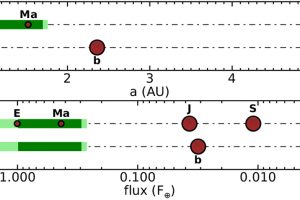Neptunians and super-Earths in systems with “cold” Jupiters as test for planetary migration theories. The study: “The GAPS programme at TNG. XXIV. An eccentric Neptune-mass planet near the inner edge of the BD-11 4672 habitable zone” of D. Barbato (UniTo/OATo) and M. Pinamonti (OATo) recently appeared on A&A

The architecture of planetary systems is result from both the planet formation process and a complex mechanism of radial migration of planets. This has occurred also in the Solar System, whose final architecture resulted from the migration of the gaseous giants. In particular, the theories describing the formation and migration of super-Earths and Neptunian planets predict different configurations of the inner planets when the systems contain also “cold” gaseous giants, e.g. giant planets with large orbital periods.
The search and characterization of planetary systems with giant planets in outer orbits and super-Earth or Neptunians in inner orbits is thus important to test models of planetary migration. These planets are more easily searched in stars less massive than the Sun (spectral classes K and M), both because of the abundance of these stars in the Galaxy, and because their properties allows a easier detection of their planets.
The team of researchers led by the astronomers D. Barbato (Università di Torino, INAF – Osservatorio Astrofisico di Torino, Observatoire de Genève) and M. Pinamonti (INAF – Osservatorio Astrofisico di Torino) analyzed a long time-series of spectroscopic data obtained in the framework of the GAPS (Global Architecture of Planetary Systems) project, together with archival data, of the K star BD-11 4672, which hosts a Jovian planet with a minimum mass of 0.53 Jupiter masses with an orbital period of 1667 days. The researchers have found evidence of another planet in the system: A Neptunian planet with a minimum mass of 15.37 Earth masses, orbiting at 0.3 AU (Astronomical Units, 1 AU is the average Earth-Sun distance, equal to 150 million km) with a period of 74 days. This newly discovered planet orbits in the outer edge of the habitability zone of the star, e.g. the region where rocky planets can host liquid water on their surfaces. Besides, the presence of this planet would make unstable any other planets in the habitable zone. The study is described in the paper: “The GAPS programme at TNG. XXIV. An eccentric Neptune-mass planet near the inner edge of the BD-11 4672 habitable zone“, recently appeared on the journal Astronomy & Astrophysics. The astronomers S. Benatti, J. Maldonado, L. Affer, A. Maggio and G. Micela of INAF-Osservatorio Astronomico di Palermo are coauthors of the paper.
The figure (click here to visualize the entire image) compares the architecture of the Solar System with that of the system of BD-11 4672, both as a function of the orbital radius and the incident stellar flux.
Mario Giuseppe Guarcello ( follow mguarce)
